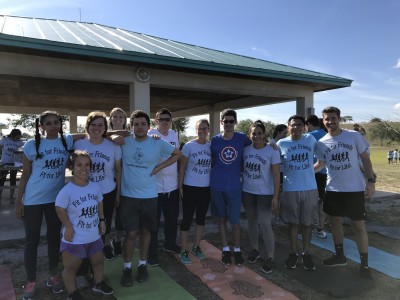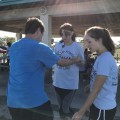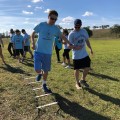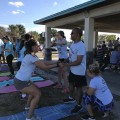NSU Newsroom
SharkBytes
Horizons
This version of NSU News has been archived as of February 28, 2019. To search through archived articles, visit nova.edu/search. To access the new version of NSU News, visit news.nova.edu.
This version of SharkBytes has been archived as of February 28, 2019. To search through archived articles, visit nova.edu/search. To access the new version of SharkBytes, visit sharkbytes.nova.edu.
Interprofessional Community-Based Fitness Program Teaches HPD Students about Autism While Serving Local Community

Occupational therapy, physical therapy, audiology, and osteopathic medicine students take a break with their partners.
For 25 years, the Dr. Pallavi Patel College of Health Care Sciences has been committed to preparing health professionals for the future demands of health care, with the ultimate goal of improving quality of life and health for patients and communities. To this end, the college and the university support innovative curricular strategies and projects that serve the local community through various outreach programs designed to promote health, wellness, and disease prevention.
“Fit for Friends, Fit for Life!” is a community-based program designed to support the needs of young adults with autism in the local community, while teaching health professions students skills for interprofessional collaboration and practice (IPE).
The changing landscape of today’s health care environment presents challenges for graduates of health professions education, including more diverse patient populations, increasing rates of specific diagnoses, and escalating health care costs. Moreover, graduates are often required to work on interprofessional teams in a variety of clinical and community-based settings. Health professionals, however, are not always adequately prepared through academic and clinical education for the shift in patient population or to work as part of interprofessional teams.1-2
Health care leaders and policymakers have recognized the importance of IPE to optimally prepare graduates to meet the needs of patients in a diverse and challenging health care system. Published recommendations support formal training for health professions students in team-based skills needed to work effectively with other professionals.3Once students understand how to work interprofessionally, they are ready to enter the workplace as a member of the collaborative practice team.4
In addition to more diverse patient populations, there has been a rise in some diagnoses, including autism spectrum disorder (ASD) and obesity. Over the past two decades, the number of persons diagnosed with ASD has increased at an alarming rate.6Children and teenagers with ASD are at greater risk for becoming overweight or obese because of the unique challenges (e.g., social communication impairments, behavioral issues, sensory processing difficulties, and motor incoordination) that limit their opportunities and abilities to exercise.6-8
The risk for obesity is compounded by dietary restrictions, medications that cause weight gain, metabolic abnormalities, and lack of knowledge or awareness.6, 8-9 Consequently, this population is at greater risk for developing diabetes or other obesity-related health issues. Engagement in physical activity can reduce this risk and has been shown to improve motor function and exercise capacity, social and communication skills, attention, motivation, self-esteem, and desire to participate in community peer activities.6,9 Individuals with ASD face barriers to participation in community-based physical activity and fitness programs, such as behavioral issues, impaired executive functioning, safety concerns, financial limitations, time, fear of bullying, lack of staff training and support, and lack of information.10
As such, there is a need for community-based wellness and prevention programs and initiatives that specifically address and support the unique needs of this growing population. Furthermore, there is evidence that interprofessional, community-based programs with typical peer partners (i.e., university students) provide social participation benefits for young adults with ASD.11
Community-based IPE programs are not only beneficial for the individuals and families served; they also are valuable for students. In addition to improving interprofessional skills, students’ involvement with persons with ASD may influence their understanding, compassion, willingness, and ability to interact with this patient population as future professionals.12
- A speech-language pathology and physical therapy student work together to assist a participant with an exercise.
- An osteopathic medicine student assists his partner with an agility drill.
- An osteopathic medicine and physical therapy student assist their partners in a strengthening activity
Furthermore, community-based programs incorporating peer mentoring (i.e., involvement of students) positively influence knowledge, attitudes, and behaviors toward individuals with disabilities.13-14 There is evidence that exposure to persons with disabilities is more effective in influencing attitudes toward disability than the provision of information alone,15 and improved attitudes positively influence level of comfort in working with patients who have disabilities.16
In the “Fit for Friends, Fit for Life!” program, faculty mentors facilitated and empowered 32 students from several health professions programs to work effectively with young adults with ASD. In the fall of 2017, students participated in monthly trainings designed to provide knowledge and skills necessary to support individuals with ASD and their families or caregivers.
In January 2018, each student was paired with a young adult with ASD, and the dyad worked together for 12 weekly sessions at a local park. Working collaboratively, students fostered engagement in physical activity and promoted the development of social connections and friendships. Students supervised the young adults during various fitness activities, demonstrated proper exercise technique, and reviewed home programs consisting of exercises and nutritional guidelines for a healthy lifestyle. Students connected with parents and caregivers to reiterate the home exercise plans and shared weekly successes.
This program provided the students with the unique opportunity to work with the young adults and their families in the community and facilitate their participation in the natural environment. Family members, and many of the young adults themselves, reported their enjoyment and appreciation for the program and expressed their desire for additional or extended opportunities to work with students on community engagement and fitness.


